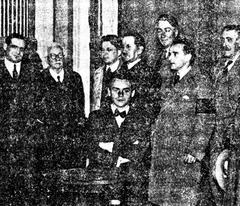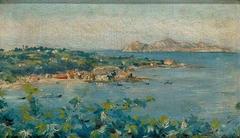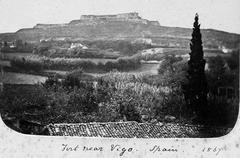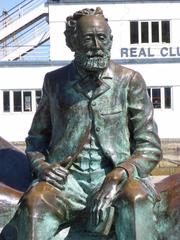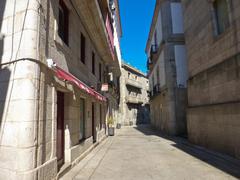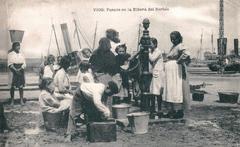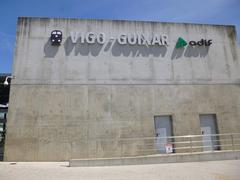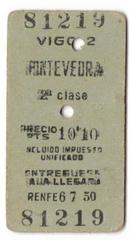
Visiting The Gate of the Atlantic (La Puerta del Atlántico), Vigo, Spain: Tickets, Hours, and Tips
Date: 04/07/2025
Introduction
Vigo, perched on the rugged northwestern coast of Spain, stands as the “Gate of the Atlantic”—a city whose culture, economy, and identity are inextricably linked to the ocean. The monumental sculpture La Puerta del Atlántico, a striking feature in Praza de América, embodies this maritime spirit and serves as a symbol of Vigo’s enduring connection to the Atlantic and its history as a departure point for Galician emigrants.
This guide provides comprehensive, up-to-date information on visiting the Gate of the Atlantic and exploring Vigo’s rich seafaring heritage. You’ll find practical details on visiting hours, tickets, access, and insider tips, as well as background on the monument’s significance, nearby attractions, and local experiences to enrich your visit.
Explore Vigo’s maritime heart, historic sites, vibrant festivals, and delectable seafood with confidence by consulting official resources and curated travel advice. Discover why Vigo remains an essential gateway between Europe and the broader Atlantic world (Turismo de Vigo, Spanish Fiestas, Facts.net).
Table of Contents
- Introduction
- Historical Background: Vigo and Its Atlantic Gateway
- The Gate of the Atlantic: Symbolism, Design, and Location
- Visiting Hours, Tickets, and Access
- Practical Visitor Tips
- Nearby Attractions and Local Experiences
- Frequently Asked Questions (FAQs)
- Visuals and Interactive Resources
- Summary and Final Tips
- References
Historical Background: Vigo and Its Atlantic Gateway
Vigo’s roots stretch back to ancient Celtic and Roman settlements, with archaeological sites like Castro de Vigo attesting to its long-standing habitation (facts.net). Its natural harbor made it a vital maritime hub for centuries, attracting fishermen, merchants, and explorers. By the late Middle Ages and into the Age of Discovery, Vigo emerged as a key port exporting Galician seafood, and in the 18th century, it became the site of notable naval conflicts such as the Battle of Rande.
The city’s identity is deeply tied to the Atlantic: its port is among the largest fishing harbors in Europe and has witnessed waves of emigration, especially in the late 19th and early 20th centuries, as Galicians set sail for the Americas (Spanish Fiestas).
The Gate of the Atlantic: Symbolism, Design, and Location
Monument Overview
La Puerta del Atlántico, created by Galician sculptor Silverio Rivas, is a monumental granite ensemble weighing over 400 tons and standing as a prominent landmark in Praza de América. The central “gate” is set within a large circular fountain, flanked by granite blocks that mark the beginnings of Gran Vía and Avenida Castelao. Its design evokes both the sails of ships and the open embrace of the Atlantic, symbolizing departure, hope, and the city’s openness to the world (Turismo de Vigo).
Cultural Significance
The monument serves as a tribute to Galician emigrants and a focal point for community gatherings. Praza de América is not only a transit hub but also a stage for public celebrations, especially during Real Club Celta de Vigo football victories and citywide festivals.
Visiting Hours, Tickets, and Access
- Opening Hours: The Gate of the Atlantic is an open-air monument accessible 24/7. Both daytime and evening visits are popular—the latter for the monument’s dramatic illumination.
- Tickets: Entry is free; no ticket is required.
- Location: Situated in Praza de América, the monument is easily reached by city bus lines, taxi, or on foot. Parking is available nearby but can be limited during major events.
- Accessibility: The site features wide, gently sloping paths, curb cuts, and level surfaces suitable for wheelchairs and strollers. Public transport options are accessible (Turismo de Vigo).
Practical Visitor Tips
Transportation and Getting Around
- By Public Transport: Several buses stop at Praza de América, connecting the monument with the city center, train station, and beaches.
- By Car: Parking is generally available near the square, though spaces fill quickly during events.
- On Foot: Vigo is a walkable city, though its hilly terrain means comfortable footwear is advised (Let’s Roam and Go).
Best Times to Visit
- Spring to Early Autumn: Warm weather, vibrant festivals, and outdoor markets make this the most popular period.
- Day vs. Night: Daytime highlights the monument’s interplay of water and granite; nighttime brings atmospheric lighting ideal for photography.
- Event Days: Join local crowds for major football celebrations or New Year’s Eve festivities at the square (Turismo de Vigo).
Accessibility
Praza de América and the monument area are wheelchair accessible. Most public spaces and attractions in Vigo accommodate visitors with reduced mobility.
Safety and Etiquette
Vigo is a safe city; however, remain aware of personal belongings during crowded events. The fountain is ornamental—avoid wading or climbing on the monument out of respect for its significance.
Nearby Attractions and Local Experiences
- Castro Fortress (Monte O Castro): Offers panoramic city and bay views; open daily, free entry.
- Museo do Mar de Galicia: Maritime museum with interactive exhibits; open Tuesday–Sunday, small entrance fee (Spanish Fiestas).
- O Berbés Fish Market: Experience Vigo’s seafood culture and sample local specialties.
- Cíes Islands: Ferries from Vigo’s port take you to this natural paradise, famed for white-sand beaches and turquoise waters (Let’s Roam and Go).
- Casco Vello (Old Town): Wander narrow streets lined with historic buildings, tapas bars, and artisan shops.
Gastronomy
Vigo is celebrated for its seafood—oysters, octopus, and empanadas are local favorites. Join a guided food tour or sample tapas at markets and taverns (Spanish Fiestas).
Frequently Asked Questions (FAQs)
Is there an entry fee for the Gate of the Atlantic?
No, the monument is free and open to the public at all times.
What are the best visiting hours?
Anytime—daylight for water features, evening for illumination. Events and festivals provide added atmosphere.
Is the site accessible for people with disabilities?
Yes, it is wheelchair accessible with flat, wide paths and curb cuts.
Are guided tours available?
Many city tours include the Gate of the Atlantic; book through the tourism office or local providers.
Where can I find restrooms or cafes?
Cafés and restaurants are plentiful around Praza de América and nearby commercial avenues.
Can I take photos?
Absolutely—early morning, late afternoon, and nighttime are best for photography.
Visuals and Interactive Resources
- View photos and virtual tours on the Turismo de Vigo website.
- Find downloadable maps and visitor guides for self-guided city walks.
- Use alt text such as “Gate of the Atlantic Vigo monument” for online searches.
Summary and Final Tips
The Gate of the Atlantic in Vigo stands as a powerful symbol of Galicia’s maritime legacy—a site of remembrance and celebration, seamlessly blending monumental art with vibrant community life. With free, all-hours access and a central location, it’s a must-see on any Vigo itinerary.
Enhance your visit by exploring nearby historical sites, indulging in local gastronomy, and joining in on festivals that bring the city’s spirit to life. For the latest information on hours, tickets, and events, consult official resources and consider using travel apps for personalized tips.
Let the Atlantic breeze and Vigo’s unique cultural tapestry inspire your journey (Turismo de Vigo, Let’s Roam and Go, Spanish Fiestas).
References and Further Reading
- Visiting Vigo: Exploring Historical Sites, Maritime Heritage, and Practical Tips, Facts.net
- The Gate of the Atlantic in Vigo: History, Visiting Hours, Tickets & Travel Tips, Spanish Fiestas
- Gate of the Atlantic in Vigo: Visiting Hours, Tickets & Architectural Highlights, Turismo de Vigo
- Gate of the Atlantic Visiting Hours, Tickets & Guide to Vigo Historical Sites, Turismo de Vigo
- Let’s Roam and Go: Is Vigo Spain Worth Visiting? Family Adventure in This Coastal Gem
- Scope Trip: Things to Do in Vigo
- Discovering Vigo: Things to Do in Vigo


